Walke I (Destroyer No. 34)
1911–1919
Henry A. Walke, born on 24 December 1809, in Princess Anne County, Va., was appointed a midshipman on 1 February 1827, and reported for duty at the navy yard in Gosport [Norfolk], Virginia. Walke received his initial naval training there and from July 1827 until November 1828 cruised the West Indies in the sloop Natchez in the campaign against pirates in that area. He made a voyage to the Mediterranean in Ontario between August 1829 and November 1831. Walke received his warrant as a passed midshipman on 12 July 1833 and after several months of post-sea duty leave, transferred to duty ashore at the Philadelphia Navy Yard on 7 March 1834. Between January 1836 and June 1839, he sailed the Pacific Station in the 74-gun ship-of-the-line North Carolina, primarily along the western coast of South America protecting American commerce during a period of unrest caused by strained relations between the United States and Mexico and the war between Peru and Chile.
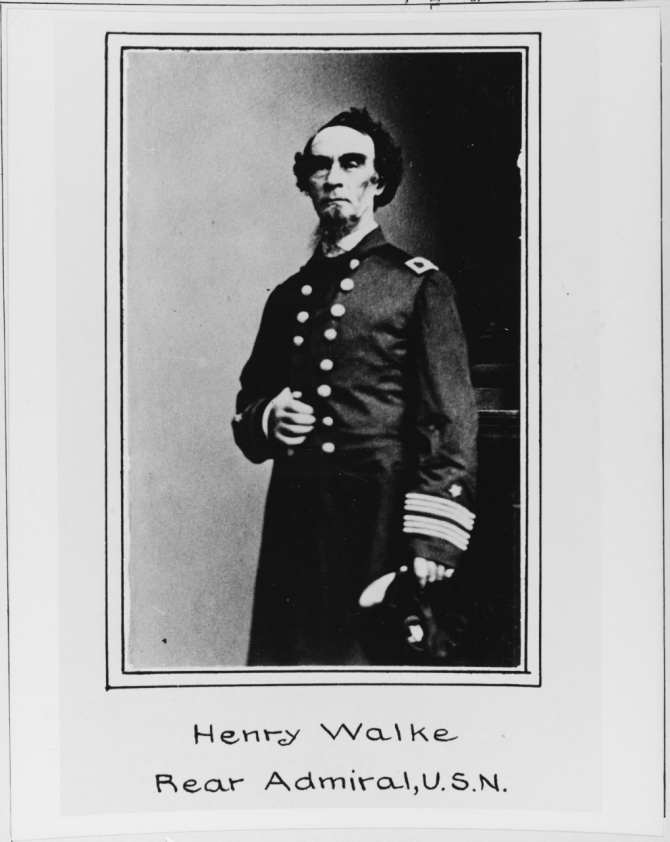
Capt. Henry Walke, shown here in service uniform circa 1863-1866, served in the U.S. Navy for nearly 40 years and retired as a rear admiral. His service took him all over the world and he would see action in such conflicts as the Mexican-American War and the Civil War. (U.S. Naval History and Heritage Command Photograph NH 66752)
During service in the receiving ship at New York, Walke was promoted to lieutenant before reporting on board Boston on 5 October 1840. While Lt. Walke was assigned to that sloop-of-war, she made a cruise to the East Indies. Returning home in 1843, he went ashore for an extended leave before returning to sea in the brig Bainbridge in May 1844 for a cruise along the Brazilian coast.
He returned home early in 1846 and after a year at various shore duties, was assigned to the receiving ship at New York, and made an eight-month voyage in Vesuvius, which participated in the Mexican War, blockading Laguna and supporting landings at Tuxpan and Tabasco. In October 1847, Lt. Walke went home for another extended leave after which he reported back to the receiving ship at New York on 22 September 1848.
On 23 June 1849, he returned to sea in Cumberland for a cruise to the Mediterranean which lasted until mid-January 1851. Following a post-voyage leave, he reported to the Naval Observatory on 22 April for a very brief tour before beginning further duty in the receiving ship at New York. That tour lasted three years, from 17 July 1851 to 17 July 1854, but consisted of two separate and very short tours of duty in the sloop-of-war, St. Mary's, during September 1853.
In January 1861, as the American Civil War approached, Cmdr. Walke found himself on board storeship Supply, at Pensacola, Fla. On the 12th, Capt. James Armstrong surrendered the navy yard to Confederate militia forces from Alabama and Florida under the command of William Henry Chase. After providing temporary support for the defenders of Fort Pickens who refused to follow Armstrong's example, Walke took off some of the loyal sailors and navy yard employees and got underway for New York on the 16th. After arriving at New York on 4 February, the commander and his ship loaded supplies and reinforcements for Fort Pickens. Supply set sail on 15 March and anchored near the fort on 7 April and landed the troops and supplies.
Operations supporting the nascent Union blockade occupied the ship for the next month, at the end of which Walke received orders to New York to take command of one of the Navy's newly acquired steamers. Following service there during the summer of 1861, as well as a four-day tour as lighthouse inspector for the 11th District early in September, Walke headed west in response to orders for special duty at St. Louis, Mo.
That assignment proved to be the command of Tyler, one of the river gunboats of the Army's Western Flotilla. In September and October, he took his gunboat downriver to bombard Confederate shore batteries at Hickman and Columbus in western Kentucky and traded a few shots with the Confederate gunboat Jackson. Early in November, his ship supported Gen. Ulysses S. Grant's move on the Southern camp at Belmont, Mo., escorting troop transports, bombarding shore batteries and, finally, covering the withdrawal of Grant's mauled forces.
In mid-January 1862, Cmdr. Walke assumed command of the ironclad gunboat Carondelet, also assigned to the Western Flotilla. In February 1862, during his tenure as Carondelet's commanding officer, Walke led her during the captures of Forts Henry and Donelson which guarded the Tennessee and Cumberland Rivers, respectively. In April, he led her in the passing of heavily fortified Island No. 10 and in the attack on and spiking of shore batteries below New Madrid, Missouri. From April through the end of June, his ship participated in the drawn-out series of operations against Plum Point Bend, Fort Pillow, and Memphis. On 15 July, Cmdr. Walke almost met his match when the Confederate ironclad ram Arkansas made its move down the falling Yazoo River toward Vicksburg. Carondelet supported by Queen of the West and Walke's former command, Tyler, engaged the Southern ironclad. During the brisk opening exchange, Carondelet suffered heavy damage and was forced out of action in a disabled, though floating, condition. Queen of the West retreated immediately, leaving only little Tyler to face the powerful ram. The Southern warship, consequently, made it safely to the stronghold at Vicksburg.
On 4 August 1862, Walke was promoted to captain and assumed command of the ironclad ram Lafayette then under conversion from a river steamer at St. Louis. He put her in commission on 27 February 1863 and commanded her during the dash past Vicksburg on 6 April and during the duel with shore batteries at Grand Gulf on the 29th. That summer, his ship briefly blockaded the mouth of the Red River early in June.
Later, on 24 July 1863, Capt. Walke was ordered back to the east coast to prepare the side-wheeler Fort Jackson for service. He put her in commission on 18 August 1863 at New York, but his command of that steamer proved brief. On 22 September, he was transferred to the screw sloop Sacramento, which he commanded through the final two years of the Civil War, and sailed the South American coast in search of Confederate commerce raiders. On 17 August 1865, he was detached from Sacramento and returned home to await orders.
On 31 July 1866, Walke was promoted to commodore. From 1 May 1868 until 30 April 1870, he commanded the naval station at Mound City, Ill. While waiting orders to his next assignment, Walke was promoted to rear admiral on 20 July 1870. He was placed on the retired list on 26 April 1871. However, his service to the Navy did not end for, on that same day, he reported for special duty under Admiral David Dixon Porter, the senior admiral of the Navy, a tour that lasted until 1 October at which time he was appointed to the Lighthouse Board. Detached on 1 April 1873, he retired to a life of writing and sketching until his death on 8 March 1896, at Brooklyn, N.Y.
I
(Destroyer No. 34: displacement 742 (normal) ; length 293'10"; beam 26'1½" (waterline); draft 9'5" (aft) (full load); speed 29.5 knots; complement 86; armament 5 3-inch, 6 18-inch torpedo tubes; class Paulding)
The first Walke (Destroyer No. 34) was laid down on 5 March 1910 at Quincy, Mass., by the Fore River Shipbuilding Co.; launched on 3 November 1910; sponsored by Miss Mildred Walke Walter, granddaughter of the late Rear Adm.Walke; and commissioned on 22 July 1911 at the Boston [Mass.] Navy Yard, Lt. Charles R. Train in command.
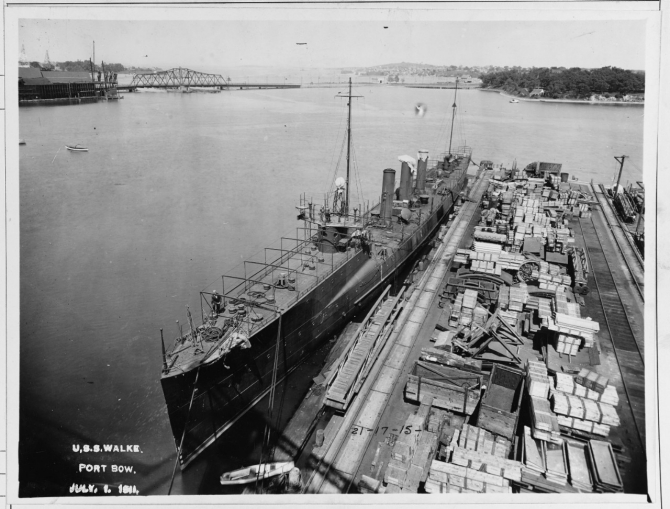
Walke fits out at the Fore River Shipyard, Quincy, Massachusetts, on 1 July 1911. Walke had her awning and bridge cover framing installed, but still lacked her guns and torpedo tubes. She was placed in commission three weeks later, on 22 July. (U.S. Naval History and Heritage Command Photograph NH 2773)
Upon commissioning, Walke was assigned to the Ninth Division, Atlantic Torpedo Fleet. After fitting out at Boston, she moved to the Torpedo Station at Newport, R.I., where she loaded torpedoes for training with the Atlantic Torpedo Fleet. During the fall and winter, the destroyer conducted battle practice and torpedo-firing exercises with the destroyers and submarines of the Fleet. In addition, she operated with the larger units of the Atlantic Fleet itself during training in more comprehensive combat drills. Those exercises covered the entire Atlantic coast from Cape Cod in the north to Cuba in the south.
Such operations occupied the destroyer until 1 November 1913, when she was placed in reserve at the New York Navy Yard. Although she remained in reserve for the next 17 months, Walke never actually went out of commission. During her semi-retirement, the ship retained a commanding officer and at least a partial crew. Though not active with the Fleet, she did get underway periodically to keep her machinery in good working order while always remaining in close proximity to New York.
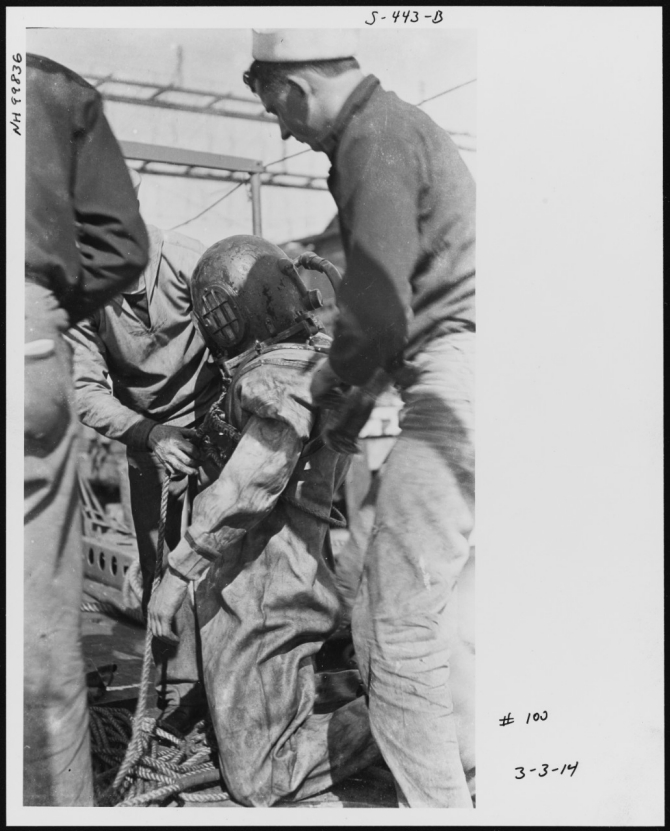
Diver preparing to go over the side of Walke on 3 March 1914. Note the airline attached to the back of his helmet. (U.S. Naval History and Heritage Command Photograph NH 99836, courtesy of Jim Kazalis, 1981)
On 3 November 1914, Walke took part in experimental deep sea diving trials that culminated in a six-man dive team made up of chief gunner’s mates that operated off the destroyer. Chief Petty Officer Stephen J. Drellishak’s dive to a then-record 274 feet (84 meters) in Long Island Sound broke the previous deep sea diving record of 211 feet set in 1907 by a British Royal Navy diver. Drellishak remained on the bottom for ten minutes and upon surfacing showed no ill effects. “I could have gone deeper,” he remarked at the time, “if the ocean floor had not been in the way or if I had brought a pick and shovel.”
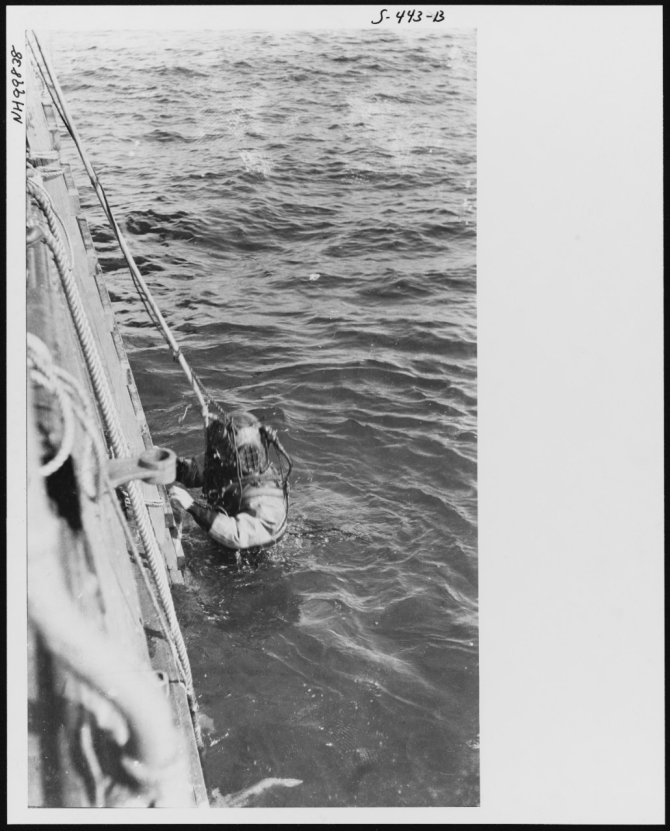
Chief Gunner's Mate Stephen J. Drellishak ascending unassisted from a ten-foot stage at the end of his record 274 foot dive from Walke to the sea floor on 3 November 1914. His ascent from the bottom occupied 1 hour and 20 minutes. This dive was one of a series of deep diving tests conducted in Long Island Sound in late October and early November 1914. (U.S. Naval History and Heritage Command Photograph NH 99838, courtesy of Jim Kazalis, 1981)
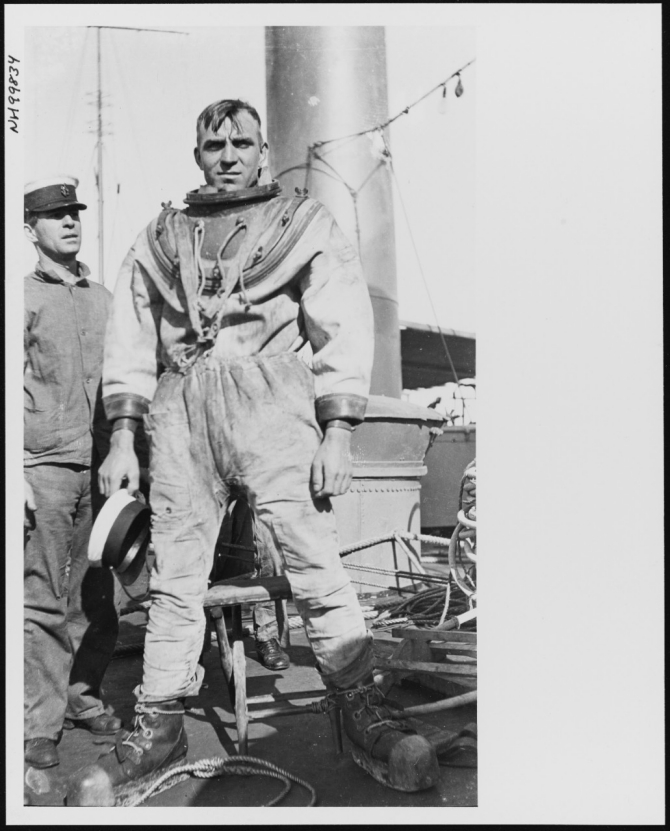
Chief Gunner's Mate Drellishak on board Walke immediately after returning from his record dive, 3 November 1914. (U.S. Naval History and Heritage Command Photograph NH 99834, courtesy of Jim Kazalis, 1981)
In July 1915, Walke returned to active service, first to participate in Independence Day celebrations at Perth Amboy, N.J., and then to visit Washington D.C., for the Grand Army of the Republican celebration in late September. By 5 October, she found herself off Newport, with the Fleet conducting maneuvers. On 1 November, Walke entered the Charleston Navy Yard for a major overhaul. Those repairs were completed at the end of February 1916; and, in March, the ship moved south to Key West to prepare for gunnery practice.
On 13 May 1916, however, revolutionary disorders broke out in the Dominican Republic, when then-Secretary of War Desiderio Arias seized power from President Juan Isidro Jimenes Pereyra. Rear Adm. William B. Caperton, Commander, Cruiser Force, Atlantic Fleet, forced Arias to leave San Domingo, when he threatened the city with naval bombardment; and Walke was dispatched to support the troops and marines landed there to restore order. Between 6 May, the day Walke had departed Key West and headed for Hispaniola, and 19 June, she cruised along the coast of Hispaniola, leaving the area periodically for fuel or provisions at Ponce, Puerto Rico, or at Guantanamo Bay, Cuba. After a brief visit to Haiti, the republic occupying the western end of Hispaniola, Walke returned to Key West on 19 June. On 21 July, she arrived at the Norfolk Navy Yard to begin an eight-month overhaul.
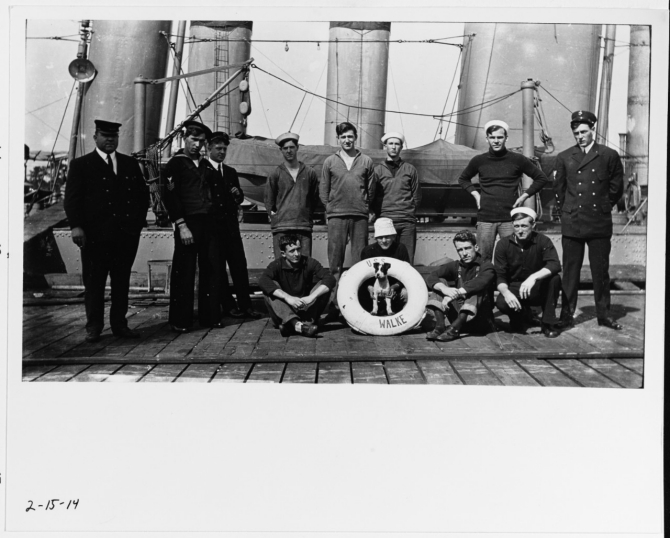
Crew members and their mascot pose on a dock alongside Walke on 15 February 1914. Note life ring with ship’s name, variety of uniforms, and the portly chief petty officer at left. (U.S. Naval History and Heritage Command Photograph NH 92534, courtesy of Jim Kazalis, 1981)
The warship completed her overhaul in March 1917 and steamed for Staten Island, N.Y. on 25 March. After she anchored in the Narrows at the New York Navy Yard with six officers and 79 sailors on board, Walke entered the New York Navy Yard on 6 April 1917-- the same day that the U.S. declared war on Germany. Two weeks and four days later, she emerged from the yard ready to go into action. After patrols off the coast of New York in late April, she voyaged to Charleston, S.C., where she arrived on 3 May. Following a 16-day visit to Charleston, she headed north and arrived back in New York on 20 May. Three days later, she put to sea bound for European waters. Because of her limited fuel capacity, the destroyer made the first three days of the voyage under tow by the collier Jupiter (Collier No. 3). Steaming under her own power after 26 May, she arrived in Gironde, France, on 5 June as part of Destroyer Force, European Waters. Following brief service there and at Brest, Walke shifted to Queenstown on the southeastern coast of Ireland on 9 June for patrol and convoy duties, that included escorting troop transports into St. Nazaire, France. From 26 August-17 September 1917, Walke was moored in Devonport, England, for repairs and upkeep.
By 17 November, she was taken in tow by Bridge (Supply Ship No.1) at a speed of 12 knots (later 13 to 13.5 knots), for the next eight days before the tow was cast off and she alternated being towed with her sister ship Perkins (Destroyer No. 26) before both warships arrived back at New York Navy Yard on 30 November. From there, Walke sailed down to Charleston Navy Yard in mid-December. Two months later, her gunner’s mates took on a complement of eight Mk. V torpedoes. With these securely on board, she sailed for the Boston Navy Yard on 16 March through the Cape Cod Canal to Long Island Sound for exercises before transiting back between Boston Navy Yard and Long Island Sound until early May. Walke then sailed back for New York Navy Yard where she remained until she received further orders.
On 5 July 1918 Walke deployed from Gravesend Bay, N.Y., on escort duty with the British troopship Aquitania to the Azores, and then made one more voyage back to Gravesend to escort outward-bound convoys that sailed the deadly Atlantic Ocean, bound for the Azores. Upon completion of her convoy duties, Walke sailed to Queenstown, whence she patrolled the western approaches to England and France, and either hunted for enemy U-boats, or escorted convoys back-and-forth from British and French ports until early November.
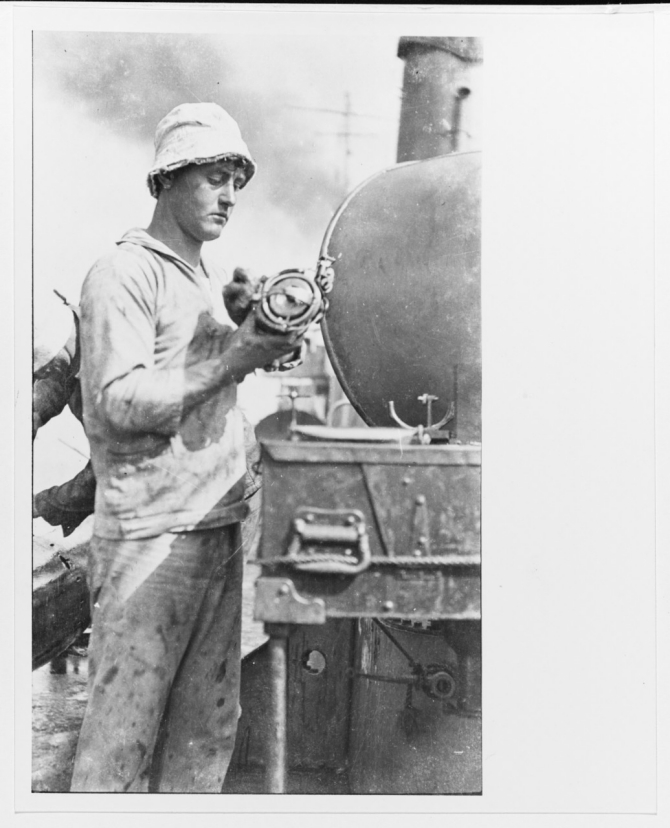
Sailor holds a gyro for an 18-inch torpedo on board Walke circa 1914. Note the ragged condition of his white hat. (U.S. Naval History and Heritage Command Photograph NH 92536, courtesy of Jim Kazalis, 1981)
On 11 November 1918, while the Armistice that ended World War I was being signed, Walke lay in the New York Navy Yard. From there, she headed south, first to Baltimore and then, on 17 December, to Hampton Roads. After steaming back to New York for the holidays, she voyaged back to Charleston for a period of repairs. She completed repairs in March 1918 and returned to New York on 16 March. Shortly after, in early April, Walke was assigned to “E” Division, Destroyer Flotilla 2. For the remainder of World War I, Walke patrolled the coastal waters of the U.S. from New York north to Cape Cod and escorted incoming and departing convoys in and out of New York harbor.
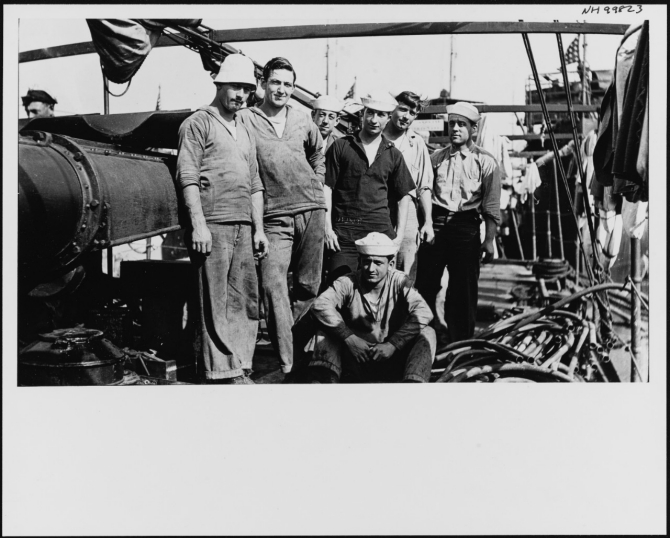
Crew members on board Walke pose by the ship's after twin 18-inch torpedo tubes, circa 1914. (U.S. Naval History and Heritage Command Photograph NH 99823, courtesy of Jim Kazalis, 1981)
Following the end of the war, Walke settled down to a routine of east coast operations and Atlantic Fleet exercises. Early in December 1918, she visited Baltimore and returned to New York on the 20th. In mid-January 1919, she moved south via Charleston to join in winter maneuvers held in the Cuba-Haiti area. Returning north by way of Key West and Miami, the destroyer reentered New York on 14 April. Between mid-April and mid-July, the warship sailed almost the entire Atlantic coast of the U.S from New York to Key West, conducting torpedo practice and various other exercises.
On 18 July 1919, Walke arrived in Philadelphia to begin preparations for inactivation. Decommissioned on 12 December 1919, Walke remained at the Philadelphia Navy Yard until the mid-1930s. She received the alphanumeric identification number DD-34 on 17 July 1920 but lost her name 13 years later on 1 July 1933 when it was reassigned to DD-416.
Known thereafter simply as DD-34, she was stricken from the Navy list on 20 March 1935 and was scrapped at the Philadelphia Navy Yard on 23 April 1935 under the terms of the London Treaty on the Limitation of Naval Armaments.
Commanding Officers Periods of Command
Lt. Charles R. Train 22 Jul 1911 – 13 Nov 1913
Ens. David I. Hedrick 13 Nov 1913 – 28 Jan 1914
Ens. Walter A. Edwards 28 Jan 1914 – 16 May 1914
Lt. Cdr. Benyaurd B. Wygant 16 May 1914 – 16 Jul 1914
Lt. (j.g.) Louis F. Thibault 16 Jul 1914 – 9 Jun 1915
Lt. Robert A.Theobald 9 Jun 1915 – 26 Oct 1916
Lt. Francis M. Collier 26 Oct 1916 – 7 Dec 1916
Lt. Charles F. Russell 7 Dec 1916 – 12 Aug 1918
Lt. Cdr. Stephan B. Robinson 12 Aug 1918 – 6 Oct 1919
Lt. Charles H. McMorris 6 Oct 1919 – 12 Dec 1919
Guy Nasuti
31 October 2016


